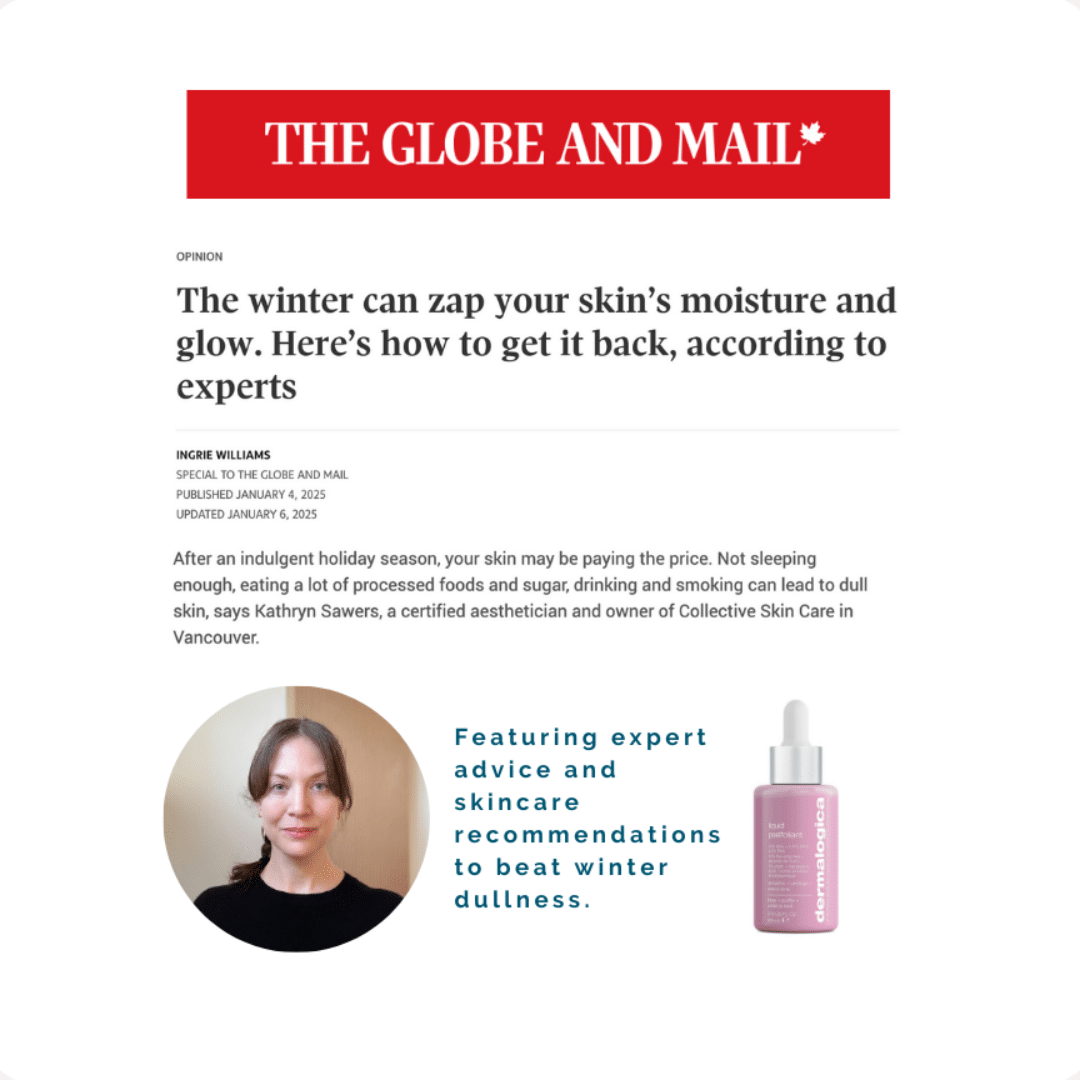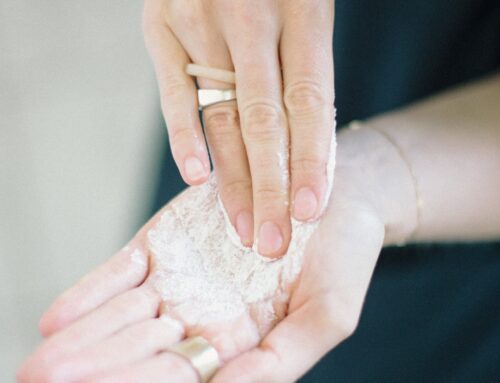Our Founder and Certified Skin Therapist Kathryn recently contributed to a Globe and Mail article about dry winter skin. The article covers the why of dry winter skin, as well as expert advice on how to get your glow back. With a cold-snap upon us in Vancouver, we felt it was timely to share the full breadth of her interview.
Read the Globe and Mail article with excerpts from this interview.
Come along as we deep-dive into dry winter skin — we will cover what happens to your skin as the temperature drops, and what you can do to address it.
The Why of Dry Winter Skin
Question: In general, what are some of the factors that can create dullness or lack of radiance in the skin?
Generally speaking there are a few factors that can contribute to dull/lacklustre skin.
1. The natural aging process which involves the rate of cell turnover slowing down and the reduction in the production of sebaceous and epidermal lips, as well as hyaluronic acid.
This affects the quality and integrity of the skin leading to surface roughness, dryness, dehydration, flakiness, and contributes to the development of fine lines and wrinkles.
2. Lifestyle factors.
- Inadequate sleep, exercise, water intake
- Poor nutrition / a diet high in processed foods and sugar
- Smoking
- Alcohol consumption
- Caffeinated beverages
- Exposure to temperature extremes (could be related to outdoor activities)
3. Skincare that is not suitable, or not being used correctly (e.g., layering hydroxy acid based products, over-use of retinol)
Question: During winter are there any specific, seasonal factors that can create dullness or lack of radiance in the skin? In other words, why does skin seem to appear so lacklustre at this time of year?
In winter, the combination of cold outdoor temperature and indoor heating can play a role in creating dull skin. Additionally the cooler weather affects the amount of sebum the skin produces and the amount of blood flow that reaches the skin. These aspects of winter conditions can leave the skin looking dull and lead to redness and/or sensitivity.
Dry Winter Skin Ingredients and How To Use Them
Question: Re: skincare ingredients, what are 3-5 of the most effective ingredients that can help get skin glowing? In other words, what are your go-to ingredients for radiant skin?
- Squalane
- Hyaluronic Acid
- Vitamin C
- Lactic Acid
Question: Please share and cover:
What are the benefits for each one and how does each one work on the skin?
Benefits of squalane and how it works
Squalane is a ceramide, often derived from olive, that helps to fill in the gaps in between the skin cells. This strengthens that skin barrier, thus preventing moisture loss and protecting the skin from external irritants/aggressors.This ingredient is great for the winter months, but also a fantastic ingredient for anyone dealing with eczema or psoriasis.
Benefits of hyaluronic acid and how it works
Hyaluronic acid is a polysaccharide that acts as a humectant, binding moisture in the skin. When the skin is adequately hydrated, it functions optimally. This positively impacts the cell turnover process, and helps to reduce skin congestion (comedones). The visible results include: reduction in fine lines, improved evenness of skin tone, refined pores, smoother texture, amplified glow.
Benefits of vitamin C and how it works
Vitamin C has multiple benefits for the skin.
● It is an antioxidant, which helps to reduce inflammation that leads to skin damage.
● It plays a part in normalizing melanin production, thus reducing the appearance of brown
spots / uneven skin tone.
● It is a precursor to the production of collagen, thus helping to maintain firmer skin.
It is a good practice to use vitamin C in the morning to provide anti-oxidant protection throughout the day. Its many benefits contribute to the visible glow it provides the skin with regular use.
Benefits of lactic acid and how it works
Lactic acid is an alpha hydroxy acid that has resurfacing, hydrating and brightening benefits for the skin. It works to resurface the skin by dissolving the bonds that hold the surface dead skin cells together to reveal the supple and vibrant skin beneath. It also slows melanin synthesis and binds water within the skin. All of these benefits make it a fantastic ingredient for glowing skin.
Question: What’s the best way to use each ingredient in a skincare routine? Any watch outs for use, like other ingredients they don’t work well with or shouldn’t be layered with? In other words, how should they be used for maximum results?
Best way to use squalane in your routine and things to look out for.
I would recommend looking for hydrating mists, serums, or moisturizers that contain this ingredient. Squalane is included in cleansers, but in my opinion if you had to choose, the best use of this ingredient is in formulations that are meant to be left on the skin.
PRECAUTION: For anyone who is concerned about animal cruelty (who isn’t?!) look closely into th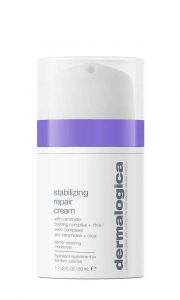 e origins of the ingredient as it can be obtained from shark liver.
e origins of the ingredient as it can be obtained from shark liver.
Product recommendation: Dermalogica Stabilizing Repair Cream — does wonders to reduce skin irritation and redness, and keeps the skin nicely moisturized and hydrated throughout the winter without feeling too heavy (texture-wise).
Best way to use hyaluronic acid and how it works
Hyaluronic acid (HA) is an extremely common ingredient that can be found in products for every step of a skincare regimen. Bearing that in mind, to benefit the most from this ingredient I recommend choosing a serum (which generally has a higher concentration of active ingredients) with varying molecular weights of hyaluronic acid (this means the HA sits at different levels of the skin). In my experience this will deliver the best results for improved skin hydration.
TIP: There is some debate about whether or not it is necessary to apply the HA serum to damp skin. The theory being that HA is a water magnet, so if you apply it to dry skin it is pulling moisture up and out of the skin. In my experience, clients do have better results when they ensure their skin is damp when they  apply an HA serum. A facial mist works well for this.
apply an HA serum. A facial mist works well for this.
Product recommendation: Dermalogica Circular Hydration Serum — it just works. Many HA serums are just so-so in terms of the results they deliver. This formula truly delivers on its promise to deeply hydrate the skin.
Best way to use vitamin C and how it works.
Like hyaluronic acid, Vitamin C is an ingredient that you will find in many different products within a skincare regimen. A serum is a great way to take advantage of the benefits of vitamin C as it is usually formulated at a higher concentration in this type of product.
Things to consider: some forms of vitamin C are more readily absorbed by the skin, and it is also an unstable ingredient. Look for a serum that is designed with the stability of the vitamin C in mind using derivatives of vitamin C that are non-irritating and bioavailable (e.g., Aminopropyl Ascorbyl Phosphate, Ascorbyl Methylsilanol Pectinate).
TIP: You generally only need to use once a day as once applied, the vitamin C will be present in the skin for up to 24 hours. Daytime is a good time to 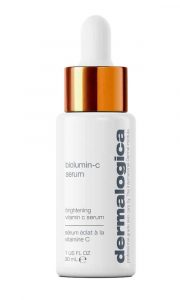 apply to benefit from antioxidant protection.
apply to benefit from antioxidant protection.
PRECAUTIONS: retinol/vitamin A based treatments are usually formulated at more alkaline pH that doesn’t work well with the acidic pH of vitamin C based products.
Product recommendation: Dermalogica Biolumin-C serum. Highly stable formula that also has a very nice texture that makes it easy to apply. Has ingredients like chia seed extract and lactic acid to moisturize and improve bioavailability of the product.
Best way to use lactic acid and how it works.
My preference when it comes to adding lactic acid into a routine is to have a specific exfoliation product. Often I find that hydroxy acids are added to cleanser, toners, and moisturizers to provide a 2 in 1 benefit, but this can easily lead to over-exfoliation if too many steps in the routine contain resurfacing ingredients. Plus, I believe you get the most benefit from using a product that is meant to perform a specific task. That’s not to say that people who are pressed for time can’t benefit from these 2 in 1 formulations. The results just won’t be quite as good as when using a focused exfoliant. Usually these types of products are in serum-like formulas, powder exfoliants, or exfoliating masques. The product that best suits an individual will depend on their skin type and condition as well as their lifestyle.
PRECAUTIONS: retinol and vitamin A based products when used alongside alpha hydroxy acid based products can weaken the skin barrier and lead to irritation, dehydration, and acne. Too much of a good thing is not a good thing in this instance, so I do not recommend using these two 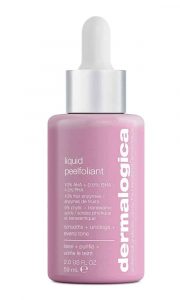 ingredients simultaneously. I would work with a skin therapist to help choose one or the other based on skin goals and lifestyle.
ingredients simultaneously. I would work with a skin therapist to help choose one or the other based on skin goals and lifestyle.
Product recommendation: Dermalogica Liquid Peelfoliant. This is actually a blend of various hydroxy acids, including lactic acid. It is a quick and easy treatment that can be used daily to resurface the skin and leave it looking fresh and glowy.
The Best Pro Treatment for Dry Winter Skin
Question: In terms of professional in-clinic treatments, what do you recommend for a wintertime glow up? Pls share a bit about the treatment(s), including how much it costs, how it works, who the ideal candidate is and what results someone can expect, timing, etc.
When considering a professional treatment for a wintertime glow up, I would recommend the microdermabrasion facial. This is a 75 minute treatment that costs $185 + GST. It includes deep pore cleansing, skin analysis, microdermabrasion, extractions, therapeutic face, neck and shoulder massage, professional serum and mask, and finishing products. I would also highly recommend the addition of LED therapy (15 minutes for $30 + GST) for the ultimate glow.
While chemical exfoliants like lactic acid can do wonders to brighten the skin and smooth its texture, because the winter weather can stress the skin barrier, when using superficial lactic acid peels in the treatment room there is greater potential to cause irritation. The wet/dry microdermabrasion technology we work with provides a deep level of physical exfoliation without the potential irritation and dryness that comes with a hydroxy acid peel. The device uses a vacuum suction combined with diamond tips of varying degrees of coarseness to sweep away surface dead skin cells. This treatment is safe for most skin types, but it is not suitable for active acne, for very thin/fragile skin, or for acutely couperose skin (lots of visible dilated vessels).
We like to refer to this treatment as a texture-tamer; it imparts a ‘glass skin’ effect. Generally the clients who have tried this treatment love the results and are hooked.
The LED add-on treatment we provide reduces inflammation, increases micro-circulation, and energizes the cells for ultra-glowy skin.
Lifestyle Tips for Dry Winter Skin
Question: Any other tips or hacks to getting glowing skin in the middle of winter you’d like to share? Please share what they are, why they work well and any pertinent how-to info.
● Increasing omega-3 intake through supplementation or diet can improve the cells ability to hold water. When the skin barrier is healthy and strong, it can properly maintain moisture levels for softer and more supple skin. An additional skin benefit from omega-3 is a reduction in the body’s production of inflammatory compounds. This slows down the triggers that lead to skin aging, as well as reducing skin redness.
● Hydrolyzed collagen powder supplements are also a helpful supplement to keep the skin hydrated and improve its elasticity from the inside out. I like to put a scoop into my tea tumbler in the morning.
The nice thing about both of these tips is that they are not just addressing the face, but the entire skin, as well as the hair and nails.
● If your skin is in need of some serious SOS, integrate the ritual of a weekly or bi-weekly hydrating and/or nourishing facial masque. Your skin will thank you, plus it’s a nice self-care ritual to do for yourself.
So there you have it — lots of dry winter skin tips that you can integrate into your skincare routine to get your glow back. If you need further help to customize your routine, feel free to book in for a skin consultation with one of our certified skin therapists.

